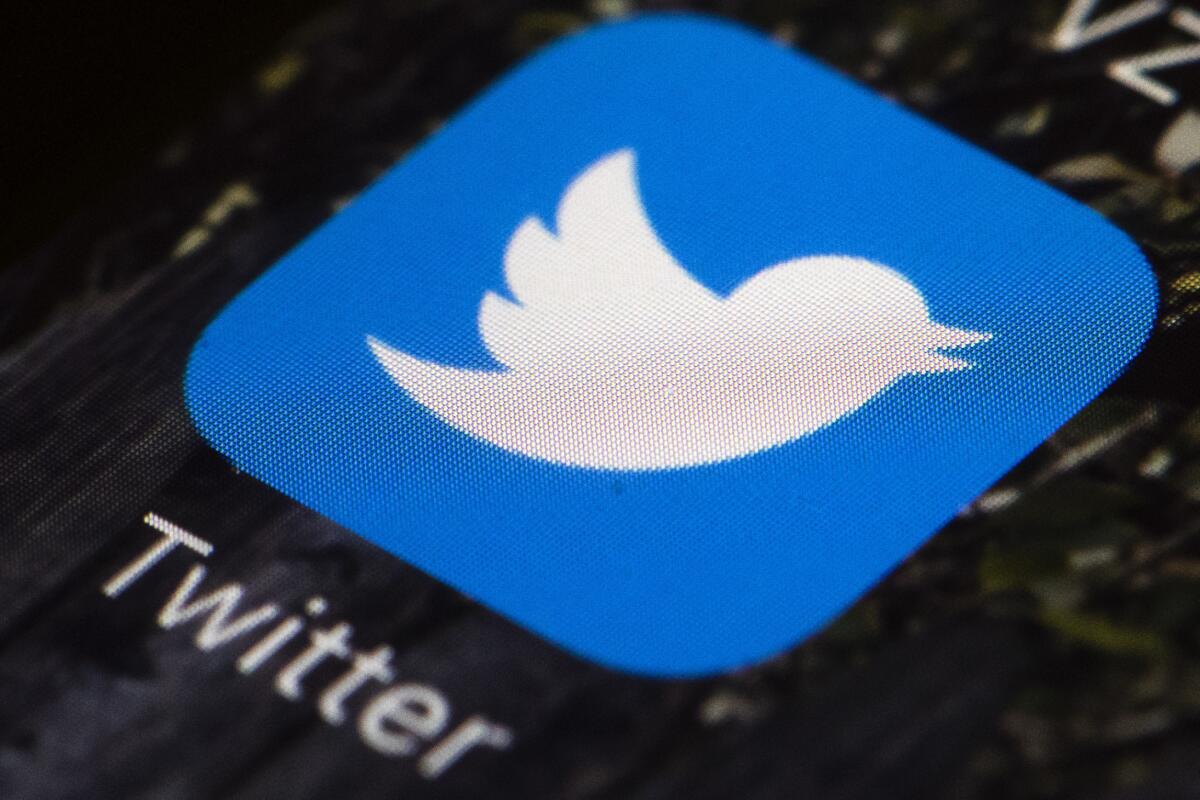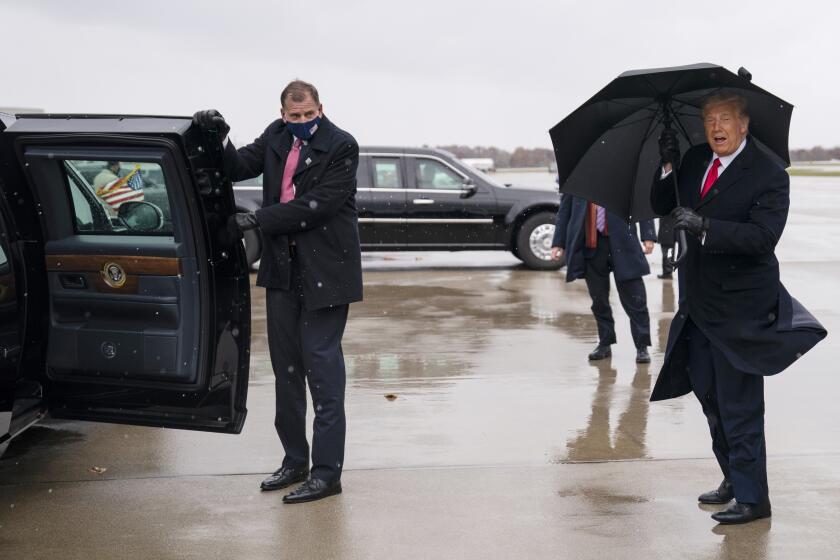Twitter flags Trump election tweets as misleading

In the run-up to the presidential election, the nationâs major social media platforms said that they were prepared for an onslaught of lies and misleading information.
The lies and fake news stories arrived on cue late Tuesday night. President Trump, along with Republican politicians and conservative media personalities, began falsely claiming that the election had been rigged against them. Their messaging continued throughout Wednesday.
The social media platforms, by and large, have moved quickly to flag high-profile false claims as potentially misleading and reduce the spread of allegations that inaccurately cast doubt on the election process.
This cat-and-mouse game of content moderation for the sake of American democracy has played out most prominently on Twitter, the presidentâs preferred platform.
The first challenge came Tuesday night, when Trump took to Twitter to share his opinion that âtheyâ are âtrying to STEAL the election.â Within 15 minutes of the post going up at 9:49 p.m. Pacific Standard Time, the presidentâs tweet had been flagged with a noticeable disclaimer, including a link to a detailed company policy on flagging and slowing the spread of misinformation.
President demands a winner be declared election night, which would mean not counting tens of millions of ballots. Democrats say itâs a sign of desperation.
Beneath the presidentâs message, Twitter also added a notice linking to the same policies.
Trumpâs election night tweet racked up thousands of retweets in the minutes between its posting and its labeling, but once it was tagged as potential misinformation, it became more difficult to share the post. When users clicked on the retweet button, they were prompted to think twice before retweeting the message, with language again linking to the misinformation policies.
Once they got past that prompt, the tweet could be only quote-tweeted, with a message attached â and even in that situation, the text of the tweet was replaced with the warning about misinformation. Twitter users still quote-tweeted the president en masse, both to critique and to support the companyâs response.
âWe placed a warning on this Tweet for making a potentially misleading claim about an election,â a Twitter spokesman said in an email. âThis action is in line with our Civic Integrity Policy, and as is standard with this warning, we will significantly restrict engagements on this Tweet.â
The challenges kept coming Wednesday as Trump continued tweeting. Twitter posted the same notice on more of his tweets, including one in which he stated that his lead in states that are âDemocrat run & controlledâ had âstarted to magically disappear as surprise ballot dumps were counted. VERY STRANGE.â
When Trump family members, campaign aides and surrogates began tweeting Wednesday that the president had won Pennsylvania â a state where much of the vote had yet to be counted â Twitter began applying the same warnings to their posts.
Just before 2 p.m. PST, Trump tweeted a message in two parts, first claiming victory in a number of states whose votes were still in the process of being tallied, and then falsely alleging that a number of ballots had been âsecretly dumped.â The first tweet was tagged with a disclaimer, saying that âofficial sources may have not called the race when this was Tweeted.â The second was fully flagged as misleading.
Earlier in the day, tweets from Wisconsin Democratic Party Chairman Ben Wikler that prematurely claimed the state as a Biden win were similarly tagged as potentially misleading by Twitter. The Associated Press has since called Wisconsin as a Biden victory.
âIâve been pleasantly surprised that they are following through and labeling the tweets,â said Lisa Fazio, a Vanderbilt psychology professor who researches how people come to believe false information, particularly on social media. Her research has shown that when stories are repeated, people are more likely to believe them, so Twitterâs mechanism of both flagging and hiding the content of potentially misleading tweets goes a long way toward slowing the spread of lies.
âWe have to be careful about how many times we let this false information be presented,â Fazio said. âEspecially when itâs not challenged.â Her research has also found that even slowing the process of spreading a news story, by asking people to type an explanation of why they believe the story to be true, can reduce the likelihood that they share a false story while having no effect on the rate of sharing true stories.
âIf you can get people to pause, theyâre much better at determining whatâs true and whatâs false,â Fazio said.
Another post on the presidentâs Twitter timeline â in which he quote-tweeted conservative blogger Matt Walsh, who quote-tweeted Matt Mackowiak, the president of the Travis County, Texas, Republican Party â showed Twitterâs mechanisms at work in triplicate. Mackowiakâs post, which questioned the legitimacy of ballot returns in Michigan, was flagged as potentially misleading. Then Walsh quote-tweeted Mackowiak, underlining the same message, and Walshâs tweet was similarly flagged. Finally, Trump quote-tweeted Walsh, writing: âWHAT IS THIS ALL ABOUT?â
Trumpâs tweet itself was not flagged as misleading, but because the other tweets down the line were, readers have to click a button to see the tweets the president is referring to and are shown the same links regarding election misinformation.
Elsewhere on Twitter, other allegations that sought to undermine the election results were deleted outright. A tweet falsely claiming that more votes had been counted in Wisconsin than there were registered voters in the state was removed from Twitter.
But the social media platformâs policies appeared to be limited to flagging misleading claims made in text, rather than in video form. More than 18 hours after Trump went live on election night to deliver a speech that sought to undermine the vote-counting process in states where he had an early lead, before the remaining votes were counted, the video of his speech remained up on Twitter.
States typically take days or weeks to finalize election results after the polls close. There has been no evidence of widespread fraud in this election or any recent presidential election, and election watchdogs have highlighted conservative politiciansâ and media personalitiesâ repeated false claims that the election process is going awry as attempts to delegitimize the vote for political gain.
Twitter put new policies and mechanisms in place following a brouhaha in October. Its decision to block users from sharing a story about Hunter Biden, son of Democratic presidential nominee Joe Biden, and a Ukrainian natural gas company provoked a furor from conservative commentators. Days later, Twitterâs chief executive, Jack Dorsey, said that the decision to block the articleâs URL was âwrong.â
The platform then rolled out universal changes to slow the spread of posts on the service, and announced new election night rules to deal with situations such as the one Trump presented.
A number of other leading social media companies have similar policies in place to deal with election misinformation, including attempts to undermine the integrity of the election process or declare premature victory.
Facebook faced challenges of its own on election night. The social media company placed links to accurate election information at the top of its feeds, but it did not flag early declarations of victory in particular battleground states as potentially misleading. On Tuesday night, in a statement to the Wall Street Journal, Facebook clarified that its policy only allowed for the flagging of outright, national declarations of early victory as potentially misleading, not early declarations of victory in particular states, despite the fact that the U.S. presidential election plays out in the details of state returns.
Times staff writer Johana Bhuiyan contributed to this report.
More to Read
Inside the business of entertainment
The Wide Shot brings you news, analysis and insights on everything from streaming wars to production â and what it all means for the future.
You may occasionally receive promotional content from the Los Angeles Times.












